Argand Plane and Polar Representation | Algebra - Mathematics PDF Download
| Table of contents |

|
| Argand Plane |

|
| Argument of z |

|
| Modulus of A Complex Number |

|
| Polar Representation |

|
| Solved Examples |

|
In the earlier classes, you read about the number line. It is a convenient way to represent real numbers as points on a line. Similarly, you read about the Cartesian Coordinate System. It is a set of three mutually perpendicular axes and a convenient way to represent a set of numbers (two or three) or a point in space.
Let us begin with the number line. Imagine that you are some kind of a mathematics god and you just created the real numbers. It so happened that you drew another line perpendicular to the real axis. What will this line be? It is definitely not real. Hence, it must be imaginary or the complex line.
Argand Plane
- The Argand plane, also known as the complex plane, is a two-dimensional plane used to represent complex numbers graphically. In this plane:
Horizontal Axis (Real Axis): Represents the real part of a complex number.
Vertical Axis (Imaginary Axis): Represents the imaginary part of a complex number.
Each complex number corresponds to a unique point in the Argand plane, and conversely, each point in the plane corresponds to a unique complex number.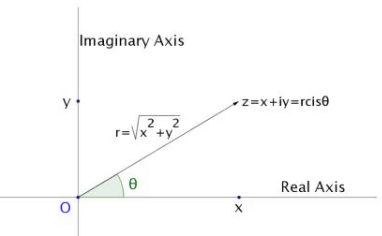
- Let z = x + iy. Then Re(z) = x and Im(z) = y. The ordered pair (x,y) represented on the Argand plane will represent a point.
- This point corresponds to our complex number z. We draw a directed line from O to the point P(x,y) which represents z.
- Let θ be the angle that this line makes with the positive direction of the “Real Axis”. Therefore, (90 – θ) is the angle that it makes with the “Imaginary Axis”. This is somewhat important, so keep it handy!
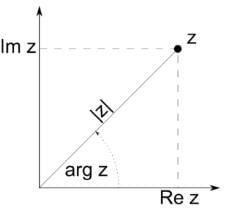
Argument of z
The argument of a complex number Z = x + iy (where x is the real part and y is the imaginary part) is given by:
arg(Z) = tan⁻¹(y/x)
This is the angle θ that the complex number Z makes with the positive real axis in the complex plane. To compute the argument:
If x > 0: The argument is simply θ = tan⁻¹(y/x), which is the arctangent of the ratio of the imaginary part to the real part.
If x < 0: The argument will be θ = tan⁻¹(y/x) + π, since the complex number lies in the second or third quadrant.
If x = 0 and y > 0: The argument is θ = π/2.
If x = 0 and y < 0: The argument is θ = -π/2.
If x = 0 and y = 0: The argument is undefined since the complex number is at the origin.
Thus, the argument of Z depends on the position of the complex number in the complex plane relative to the real axis.
Modulus of A Complex Number
The modulus of a complex number is the distance of the point representing the complex number from the origin in the complex plane. It is denoted as |z|, where z is a complex number.
If a complex number is given in the form:
z = a + bi
Where:
- a is the real part of the complex number,
- b is the imaginary part of the complex number.
Then the modulus of z is calculated as:
|z| = √(a² + b²)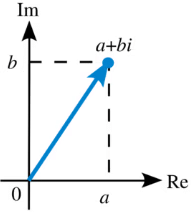
Explanation
- The complex number z = a + bi can be represented as a point (a, b) in the complex plane, where the x-axis represents the real part and the y-axis represents the imaginary part.
- The modulus is simply the straight-line distance from the origin (0,0) to the point (a, b) in the plane.
- By using the Pythagorean theorem, the distance (or modulus) is calculated as the square root of the sum of the squares of the real and imaginary parts.
- Example
For the complex number z = 3 + 4i, the real part a = 3 and the imaginary part b = 4.The modulus is:
|z| = √(3² + 4²) = √(9 + 16) = √25 = 5
So, the modulus of z = 3 + 4i is 5.
Polar Representation
In polar coordinates, a point in the plane is described by two values: the radius (r) and the angle (θ).
- Radius (r): The distance from the origin (the center of the coordinate system) to the point.
- Angle (θ): The counterclockwise angle between the positive x-axis and the line connecting the origin to the point.
Basic Polar Representation - A point (P) in polar coordinates is written as (r, θ).
Where: - r is the distance of the point from the origin.
- θ is the angle measured counterclockwise from the positive x-axis.
Conversion (a) From Cartesian to Polar Coordinates:
- Given a point (x, y) in Cartesian coordinates:
- r = √(x² + y²)
- θ = tan⁻¹(y/x) (Note: The angle θ depends on the quadrant the point lies in.)
- Given a point (x, y) in Cartesian coordinates:
(b) From Polar to Cartesian Coordinates:
- Given a point (r, θ) in polar coordinates:
- x = r * cos(θ)
- y = r * sin(θ)
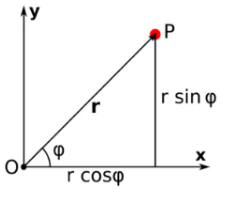
- Similarly, if we know the Argument of a complex number in the Argand Plane and the length OP, we can locate the said number. Let r = OP. We also know that OP = |z| = r ; where z = x + iy
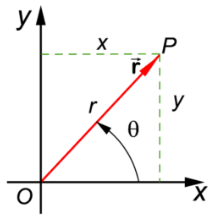
- The coordinates of P are (x, y). In the right angled triangle, we see that x = r cos(θ) and y = r sin(θ). So we can write, z = r cos(θ) + r sin(θ) = r [cos(θ) + sin(θ)]. This, my dear friends, is the Polar representation of our complex number z = x + iy with:
Arg(z) = θ and |z| = r
Now y/x = r sin(θ)/r cos(θ) = tan θ - Therefore, θ = tan-1(y/x)
Using this relation, we can find the argument of a complex number.
- Given a point (r, θ) in polar coordinates:
Solved Examples
Example 1: If z = −2(1+2i)/(3 + i) where i=(  ), then the argument θ(−π < θ ≤ π) of z is:
), then the argument θ(−π < θ ≤ π) of z is:
(A)3 π/4
(B) π/4
(C) 5 π/6
(D) -3 π/4
Ans: (D)
Sol:As z = −2(1+2i)/(3 + i)
Multiplying and dividing by (3 – i), we get
z = -2(1+2i)×(3 – i)/(3 + i)×(3 – i) = -1 – i
Comparing this to z = x + iy, we have x = -1 and y = -1
Therefore, θ = tan-1(y/x) = tan-1(1) = -3 π/4
Why not π/4 ? Well because, both x and y are negative. This means that the point P is in the third quadrant now. Therefore, θ = -3 π/4.
Example 2: Find the modulus and argument of the complex number z = 3 + 4i.
Sol: Modulus of z
The modulus of a complex number z = a + bi is given by:
|z| = √(a² + b²)
For z = 3 + 4i, we have a = 3 and b = 4.
|z| = √(3² + 4²) = √(9 + 16) = √25 = 5
So, the modulus of z is 5.
|
181 videos|58 docs
|
FAQs on Argand Plane and Polar Representation - Algebra - Mathematics
| 1. What is the Argand Plane in mathematics? |  |
| 2. What is the polar representation of a complex number? |  |
| 3. How can we convert a complex number from the Argand Plane to polar representation? |  |
| 4. What are the advantages of using polar representation of complex numbers? |  |
| 5. Can we convert a complex number from polar representation back to the Argand Plane? |  |















